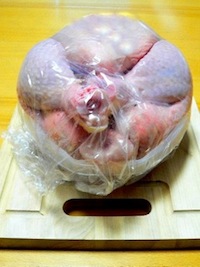By Lisa O’Connor
Introduction:
Up until 2011, the majority of pre-packaged whole chickens sold on the Irish market were packaged in a way that meant leakage of meat juices was relatively common. Typically the birds were sold on a tray with plastic wrapped around the meat and heat sealed under the tray. When condensation built up during chilled storage the seal was easily loosened and liquid could leak out through the bottom of the packaging. The change in poultry packaging was brought about by Irish evidence that Campylobacter could be found on the surface of the packaging.
FSAI Study:
A study (FSAI 2010a) was coordinated by the Food Safety Authority of Ireland (FSAI) and conducted by the Health Service Executive (HSE) during September to December 2008. Seven hundred and eighty five samples (whole birds and chicken portions) were taken by Environmental Health Officers (EHOs). Each sample consisted of a pair of swabs: one from the exterior of the chicken packaging and one from the cabinet displaying that package. Samples were analysed for the presence of Campylobacter in the HSE Official Food Microbiology Laboratories. Contamination was detected on 13.2% (104/785) of the external surface of packaging and 10.9% (86/785) of the surface of display cabinets.
The survey included a questionnaire which captured information on the sample source, the packaging type and the sample and had a response rate of 75% (590/785). Based on statistical analysis the microbiological results of this subset of 590 samples were considered representative of the total sample population. Almost two thirds of the packaging sampled (61.2%, 361/590) was identified as conventional packaging (i.e. the plastic covering wrapped around the tray and sealed underneath); while, one third (32%, 189/590) was considered to be leak-proof packaging (i.e. the plastic wrapping sealed onto the tray).
Results:
The following are key findings relating to packaging which were found to be statistically
significant (p<0.05):
• Campylobacter were detected on the exterior of 18.9% (68/361) of conventional
packaging and 2.1% (4/189) of leak-proof packaging.
• Campylobacter were detected on 13.9% (50/361) of display cabinets in contact
with conventional packaging; while Campylobacter were detected on only 2.6%
(5/189) of display cabinet surfaces in contact with leak-proof packaging.
• When chicken was packaged in the conventional manner, leakage was evident
on 17.2% (62/361) of display cabinets. With leak-proof packaging, leakage was
evident on only 6.3% (12/189) of display cabinets.
• Campylobacter were detected on 19.5% (71/365) of packages containing whole
birds compared to 3.2% (7/221) of packages containing chicken portions.

The survey also sought to establish whether handling and cooking instructions deviated from accepted best practice. One-third of samples (194/590) provided handling, preparation and/or cooking instructions on the front of the label. Of the 381 samples which did not provide such instructions on the front of the label, 63% (240/381) carried these instructions on the reverse of the label. To view this information the consumer would either have to peel off the label (which can be difficult to do), or look at the label through the plastic film. This latter practice could encourage consumers to touch the internal surface of the packaging which would be expected to be more contaminated than the external surface. In addition, 6.8% (25/365) of whole bird’s labels carried instructions advising customers to wash the whole bird or the cavity of the bird prior to cooking. This instruction is contrary to current best practice advice and can lead to the spread of Campylobacter around the kitchen in water droplets.
Recommendations:
Based on the survey findings, FSAI made recommendations to retailers to control the risk of cross contamination from conventional packaging, to change to sourcing chicken in leak-proof packaging and to change labels which carry cooking and handling instructions that are contrary to accepted best practice. While retailers and poultry processors were working on packaging solutions, FSAI in consultation with its Retail Forum produced guidance (FSAI 2010b) on handling and storage practices to minimise leakage from conventional packaging. The message to consumers was to continue to keep raw meat separate from ready-to-eat foods while shopping, storing and preparing food. Where consumers use reusable bags they were advised to consider designating one bag for use with raw meats only.
Unfortunately, there has been an upsurge in cases of campylobacteriosis reported to the Health Protection Surveillance Centre (HPSC) since the start of 2011 (prior to the introduction of the packaging) which continued throughout the year (HPSC 2012). Preliminary data for 2012 suggests that this elevated level appears to have been sustained this year. Despite analysis of the distribution of cases by age, sex and HSE-area, the HPSC has not been able to determine the cause of this increase. Interestingly, a similar increase has been reported in the UK where the Authorities have also been unable to identify the cause(s).
Conclusions:
In conclusion, it appears that any positive public health impact from the improved packaging may have been masked by other factors, which may be unrelated to poultry. However, feedback from industry indicates a great improvement in the amount of leakage on poultry shelves and given the high level of Campylobacter in poultry, this has to be a good thing. The FSAI continues to work with stakeholders to grind away at this public health problem which in 2011 caused almost eight times more cases of infectious intestinal disease than Salmonella.
References:
FSAI (2010a) Third National Microbiological Survey 2008 (08NS3): Prevalence of
Campylobacter spp. on (a) surface of chicken packaging and (b) surface of display
cabinets.
FSAI (2010b) How to Minimise the Risk of Leakage of Potentially Contaminated
Juices from Fresh Poultry Products.
Available at:
HPSC (2012) Surveillance of Infectious Intestinal (IID), Zoonotic and Vectorborne
Disease and Outbreaks of Infectious Disease in Ireland. Quarter 4 – 2011 Report.
Dr Lisa O’Connor, a Past President and Fellow of the Institute of Food Science
and Technology of Ireland, is Chief Specialist in Food Science at the Food
Safety Authority of Ireland, Abbey Court, Lower Abbey Street, Dublin 1, Ireland;
www.fsai.ie
IUFoST Scientific Information Bulletin (SIB)
FOOD FRAUD PREVENTION